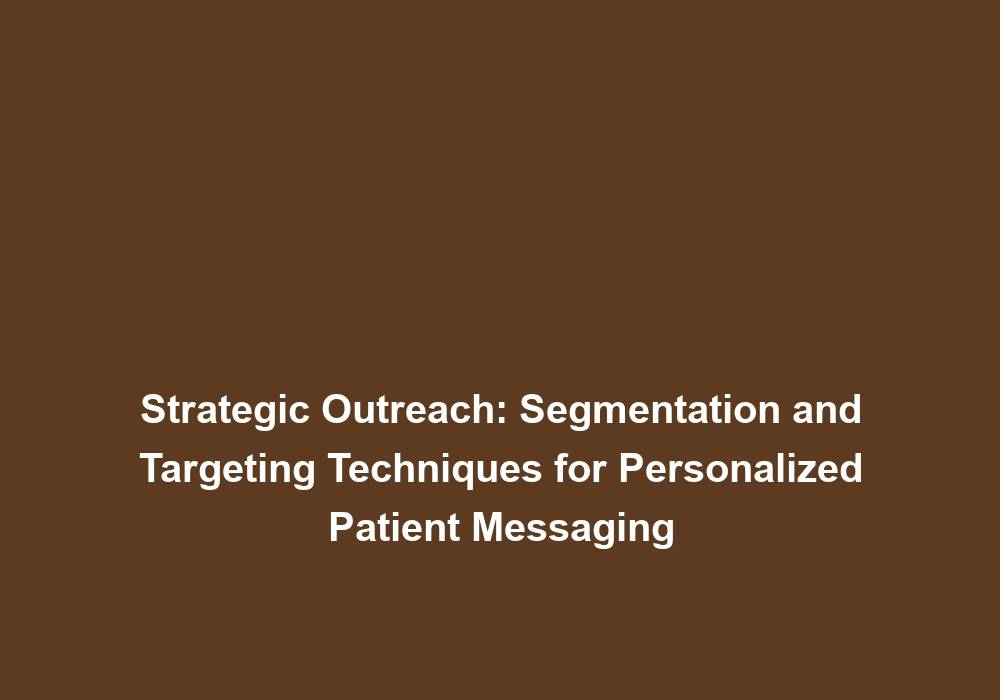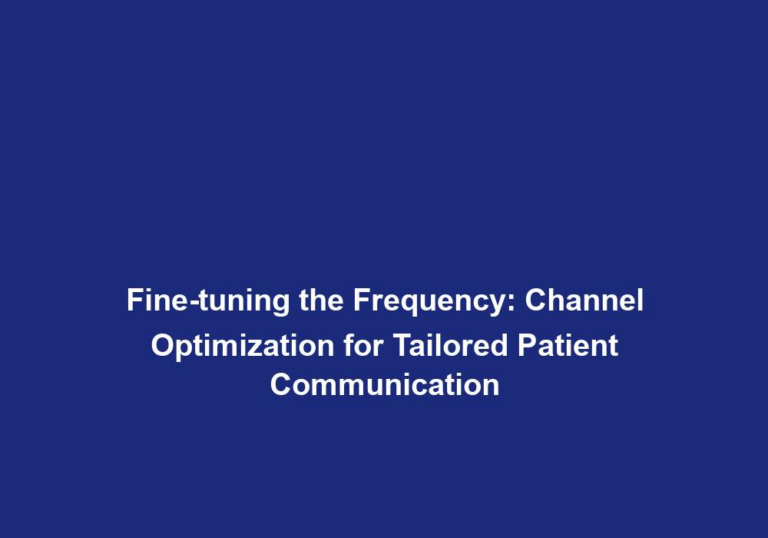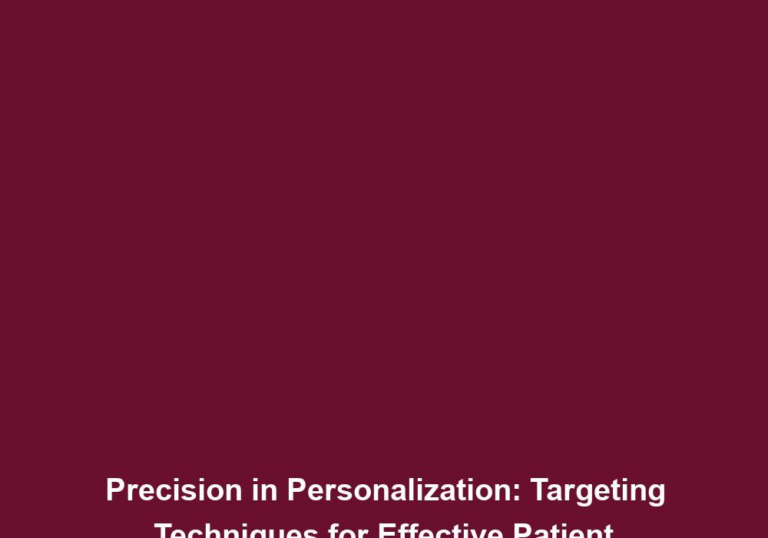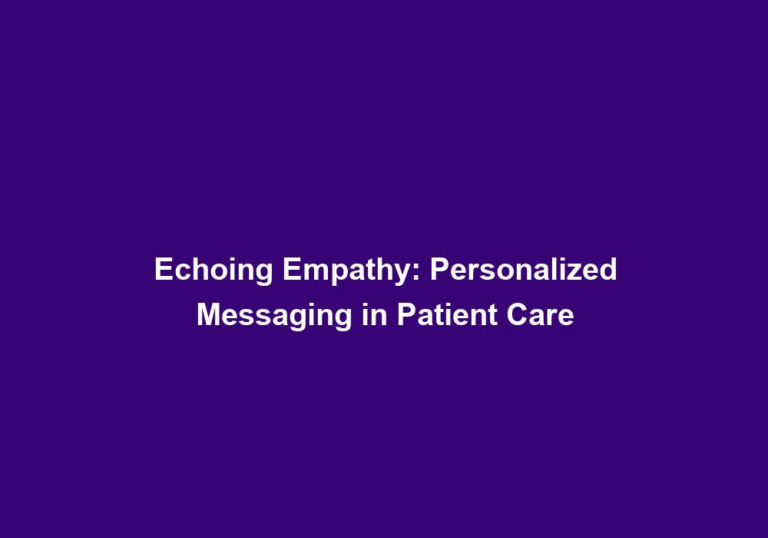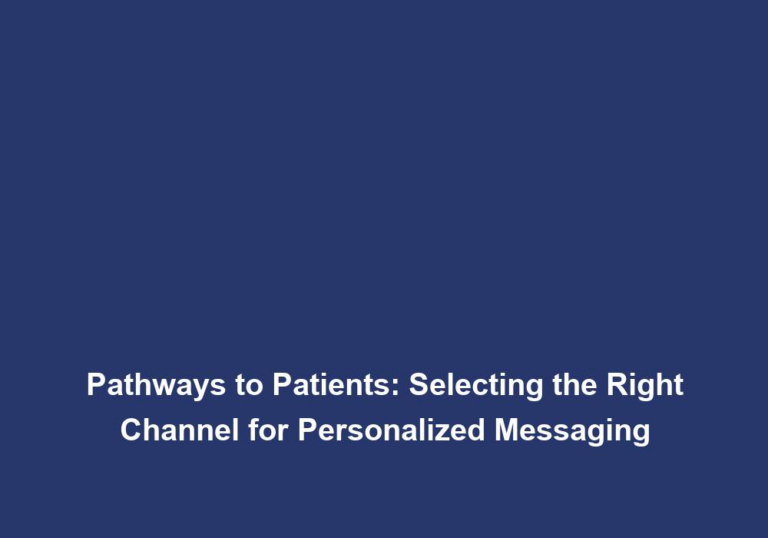Strategic Outreach: Segmentation and Targeting Techniques for Personalized Patient Messaging
In the fast-paced world of healthcare, maintaining a personal connection with patients can be a challenge. However, with the advent of modern technology and the growing importance of patient satisfaction, personalized messaging has emerged as a powerful tool in enhancing patient care. By tailoring communication to the unique needs and preferences of each individual, healthcare providers can foster empathy, improve patient engagement, and ultimately achieve better outcomes. In this article, we will explore the significance of personalized messaging in patient care and discuss effective strategies for implementing it.
The Importance of Empathy in Healthcare
Empathy, the ability to understand and share the feelings of another person, is crucial in healthcare. When patients feel understood and valued, they are more likely to trust their healthcare providers and actively participate in their own care. Moreover, empathetic communication has been associated with better treatment adherence, increased patient satisfaction, and improved health outcomes.
Empathy is the foundation of a strong patient-provider relationship. When healthcare providers demonstrate empathy, they create a sense of trust and safety for patients, encouraging them to open up about their concerns and actively engage in the decision-making process. This leads to improved treatment outcomes and patient satisfaction.
To cultivate empathy in healthcare, personalized messaging plays a pivotal role. By tailoring communication to each patient’s unique needs and circumstances, healthcare providers can demonstrate that they truly understand and care about the individual. This can be achieved through active listening, using empathetic language, and showing genuine concern for the patient’s well-being.
The Power of Personalized Messaging
Personalized messaging leverages the power of empathy by tailoring communication to the unique characteristics and circumstances of each patient. It goes beyond a one-size-fits-all approach and recognizes that every patient is an individual with distinct preferences, needs, and concerns. Whether it is through face-to-face interactions, phone calls, emails, or digital platforms, personalized messaging allows healthcare providers to connect with patients on a deeper level and establish a stronger therapeutic relationship.
One of the key benefits of personalized messaging is that it creates a sense of personalization and individualized attention for patients. When healthcare providers take the time to understand a patient’s preferences, concerns, and goals, they can craft messages that resonate with the individual on a deeper level. This leads to improved patient satisfaction and engagement.
Personalized messaging also helps to overcome barriers in communication. Patients may feel overwhelmed or confused by medical jargon and complex information. By adapting language and tone to match the patient’s level of understanding, healthcare providers can ensure that the message is clear and easily comprehensible. This facilitates effective communication and promotes patient empowerment.
Furthermore, personalized messaging allows healthcare providers to address the specific needs and concerns of each patient. Whether it is providing educational resources, appointment reminders, or follow-up instructions, tailored messages ensure that patients receive information that is relevant to their individual circumstances. This helps patients feel supported and cared for, leading to improved treatment adherence and better health outcomes.
Strategies for Implementing Personalized Messaging
- Collect Comprehensive Patient Information: To effectively personalize messaging, healthcare providers should gather comprehensive patient information. This includes not only medical history and current symptoms but also preferences, cultural background, and communication preferences. Electronic health records can be a valuable tool in capturing and organizing this information.
Gathering comprehensive patient information is essential for understanding each patient’s unique needs and tailoring messages accordingly. This information can include demographic details, medical history, lifestyle factors, and psychosocial considerations. By having a complete picture of the patient, healthcare providers can deliver messages that resonate with their individual circumstances.
- Develop Patient Personas: Creating patient personas can help healthcare providers better understand their patients and tailor their messaging accordingly. Personas are fictional representations of different patient types, incorporating demographic information, medical history, and psychosocial factors. By developing personas, healthcare providers can anticipate patient needs and craft messages that resonate with them.
Patient personas provide a framework for understanding the diverse range of patients that healthcare providers may encounter. By creating personas based on demographic information, medical conditions, and psychosocial factors, healthcare providers can tailor their messages to specific patient segments. This ensures that the messages are relevant, relatable, and effective in engaging patients.
- Use Patient-Preferred Communication Channels: Personalized messaging extends beyond the content itself to the mode of communication. Some patients may prefer face-to-face interactions, while others may prefer digital communication channels such as emails or secure messaging platforms. Understanding and respecting patient preferences is essential for effective personalized messaging.
Patients have different communication preferences, and healthcare providers should accommodate those preferences to enhance patient engagement. By using the communication channels preferred by patients, such as phone calls, emails, or secure messaging platforms, healthcare providers can ensure that the messages reach the patients in a manner that is convenient and comfortable for them.
- Adapt Language and Tone: Personalized messaging involves using language and tone that are appropriate and understandable to each patient. Healthcare providers should avoid jargon and use clear, concise language. Additionally, they should adapt their tone to match the patient’s emotional state, providing reassurance and support when needed.
Language and tone play a critical role in effective communication. Healthcare providers should use language that is easily understandable and avoid the use of medical jargon. Additionally, they should adapt their tone to match the patient’s emotional state, showing empathy and understanding. This helps to establish a connection with the patient and promotes effective communication.
- Tailor Content to Patient Needs: The content of personalized messages should address specific patient needs and concerns. Whether it is providing educational resources, appointment reminders, or follow-up instructions, healthcare providers should ensure that the information is relevant and actionable. This demonstrates to patients that their individual needs are being considered.
Tailoring content to patient needs is essential for personalized messaging. Healthcare providers should consider the specific needs and concerns of each patient when crafting messages. This can include providing educational resources that address the patient’s condition, sending appointment reminders tailored to their preferences, or offering follow-up instructions that are practical and easy to understand. By addressing specific patient needs, healthcare providers can demonstrate their commitment to providing individualized care.
Benefits of Personalized Messaging in Patient Care
Implementing personalized messaging in patient care yields numerous benefits, both for patients and healthcare providers. Some of the key advantages include:
-
Enhanced Patient Engagement: Personalized messaging promotes active patient engagement by fostering a sense of partnership and collaboration in the healthcare journey. By tailoring communication to individual preferences, patients are more likely to feel involved and empowered in their own care.
-
Improved Patient Satisfaction: When patients receive personalized messages that address their unique needs and concerns, their overall satisfaction with the healthcare experience increases. This leads to stronger patient-provider relationships and higher ratings of healthcare providers.
-
Increased Treatment Adherence: Personalized messaging has been shown to improve treatment adherence rates. Patients are more likely to follow through with treatment recommendations and medication regimens when they receive personalized reminders and educational materials that resonate with their specific situation.
-
Better Health Outcomes: By establishing a strong therapeutic relationship and promoting patient engagement, personalized messaging has the potential to improve health outcomes. Patients who feel supported and understood are more likely to take an active role in managing their health, leading to better overall outcomes.
Conclusion
In the era of personalized medicine, personalized messaging plays a crucial role in patient care. By tailoring communication to the unique needs and preferences of each patient, healthcare providers can enhance empathy, improve patient engagement, and achieve better health outcomes. By collecting comprehensive patient information, developing patient personas, using patient-preferred communication channels, adapting language and tone, and tailoring content to patient needs, healthcare providers can effectively implement personalized messaging strategies. The benefits are manifold, ranging from increased patient satisfaction and treatment adherence to improved overall health outcomes. Embracing personalized messaging is a powerful step towards providing patient-centric care and fostering empathy in the healthcare system.

